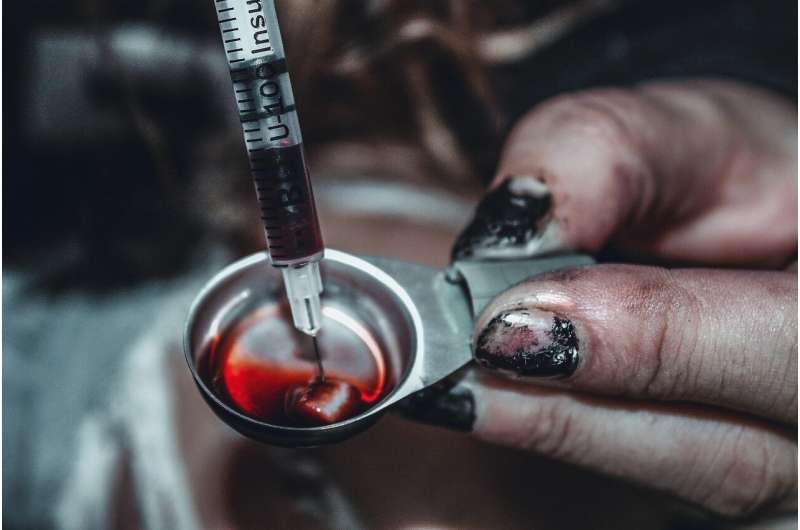Buvidal: Is it really a game changer in the treatment of problematic opioid use?

To overcome problematic opioid use, traditional forms of opioid substitution therapy, such as methadone and oral buprenorphine, have become valuable tools. Research shows that patients receiving substitution therapy are more likely to stay in treatment and stop using heroin than patients receiving treatments that do not involve substitutes—such as counseling or group therapy.
But not all those on substitute medication are able to stop using illicit opioids. Some continue to use them in addition to the substitute. One barrier to success is the need to attend a clinic or pharmacy every day, or every few days, to obtain the substitute.
In early 2019, a new form of substitute treatment, long-acting injectable buprenorphine, was approved for use in the UK. Unlike methadone and oral buprenorphine, long-acting injectable buprenorphine is administered via an injection either weekly or monthly. The treatment—also known by its brand names Buvidal or Sublocade—has been heralded as a “game changer” by both doctors and patients.
Opioids
In 2021, nearly 5,000 drug-related deaths were registered in England and Wales. About half of those involved an opioid.
Opioids are a class of drugs that include substances derived from the opium poppy. They include morphine and heroin, as well as synthetic alternatives that mimic the effects of naturally occurring opioids such as tramadol and fentanyl.
Opioids work in the brain to produce a variety of effects, including pain relief. They also produce feelings of euphoria, joy and pleasure. Opioids have a depressant effect on the body, so if someone overdoses, they can stop breathing and may die. Overdose is a particular risk for those who use illegally obtained opioids of unknown strength, such as heroin.
Often people are unable to stop using opioids despite the risk of death and the serious negative health and social consequences. Such drugs are hard to give up, partly because stopping causes painful physical and psychological withdrawal symptoms.
Opioid substitution therapy
An effective form of treatment for problematic opioid use is opioid substitution therapy, where illegally obtained opioids are substituted for prescribed alternatives.
Providing a legal substitute of known purity is useful in many ways. Most notably, it removes the need to buy and use illicit opioids. This reduces the risk of overdose and the need to commit crimes like theft and shoplifting to get money to pay for drugs.
But while daily attendance and supervised consumption may help to minimize the risk of misuse, it also has its drawbacks. For example, it can bring patients into regular contact with their former drug-using networks and can require time-consuming journeys that interfere with employment, education and other responsibilities.
Long-acting injectable buprenorphine does not have these drawbacks. It is not unlike long-acting forms of contraception, in that the medicine releases slowly over time, thereby avoiding the peaks and troughs associated with oral formulations.
When the pandemic broke and the UK went into lockdown, concerns were raised by experts that daily attendance at clinics or pharmacies for opioid substitution medication might increase the risk of COVID transmission.
Keen to stop the spread of the virus while also providing safe and continuous treatment to patients, the Welsh government agreed to fund the roll-out of long-acting injectable buprenorphine to drug services across Wales.
That decision was supported by emerging evidence of the effectiveness of the medication from a drug service in south Wales that had been piloting the medicine before the pandemic.
Results
While the primary aim at that time was to stop the spread of COVID, it quickly became clear that the medication was benefiting patients in many other ways.
Patients taking part in a survey about the new medication reported reductions in cravings, lower levels of anxiety, reductions in offending and abstinence from illicit opioids. They described rebuilding their lives, getting jobs, reconnecting with family members and heralded long-acting injectable buprenorphine as a “game changer”, “life changing” and even a “miracle”.
Positive results have also been reported in systematic reviews that summarize the findings of the currently small, and not very robust, body of evidence on the effectiveness of the medication.
However, alongside the reports of success, less positive stories have emerged suggesting that the treatment may not be a silver bullet. Some patients have found the transition onto the medication challenging because it required them to be in full withdrawal before their first dose.
Others have been overwhelmed with emotions because the medication made them feel so clear-headed that their past traumas—suppressed by years of illicit opioid use—had begun to resurface. There have also been reports of an increase in crack cocaine use among some patients and concerns about the reduced amount of contact (from daily to monthly) with drug services.
Even though there is a “ceiling effect” that reduces the risk of overdose, this medication still carries a risk of respiratory depression. This risk is greater among those using alcohol, benzodiazepines or other opioids such as heroin.
Long-acting injectable buprenorphine is still in its infancy worldwide, so the evidence for its effectiveness is slim. To determine if it really is a “game changer”, experts will need to look at its impact across a wider range of outcomes over longer periods and with larger samples than have been considered to date.
Provided by
The Conversation
This article is republished from The Conversation under a Creative Commons license. Read the original article.
Source: Read Full Article


